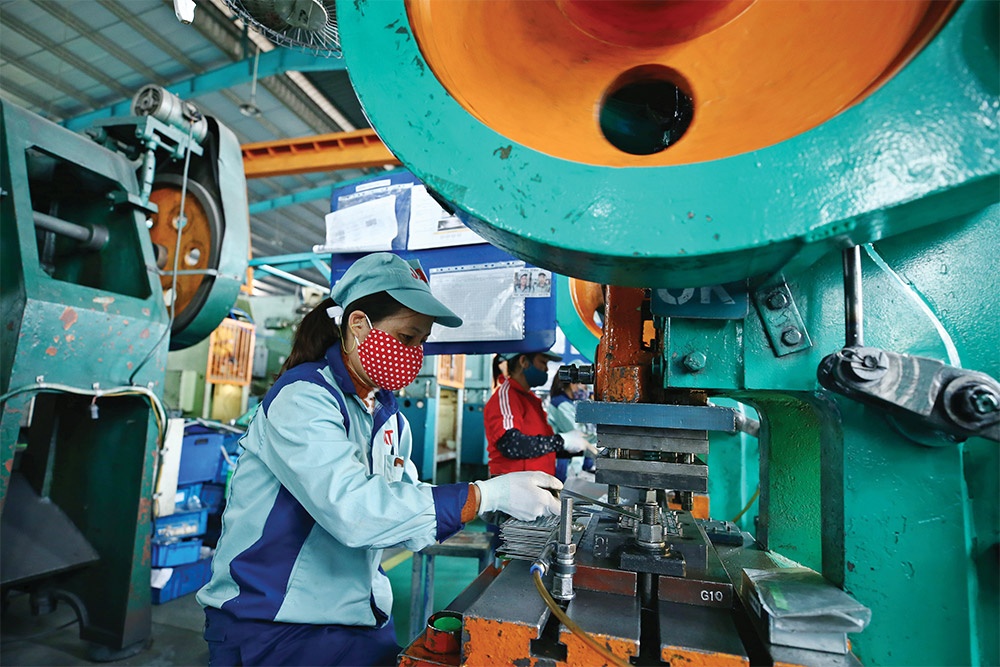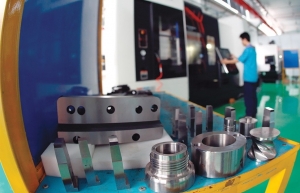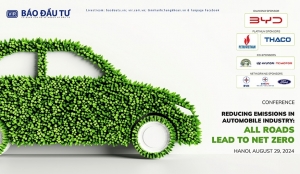Connections being improved for supporting industries
 |
| Investment and expansion are the main channels through which supporting industries can improve, photo Duc Thanh |
At last week’s Supporting Industry Exhibition Fair in Hanoi, organised by the Department of Industry and Trade, Nguyen
Hoang, chairman of the Hanoi Supporting Industry Business Association (Hansiba), said that thanks to strong support from the government, infrastructure, input materials, and partner connections for enterprises had improved.
“Although the global economic situation is fluctuating, the number of orders is still meeting the targets set at the beginning of the year, helping maintain stable production both this year and in the near future,” said Hoang.
Hoang Huu Yen, general director of Hanoi-based automation and energy solutions provider Intech Group, noted that the market this year was more vibrant than last year. As of September, the company’s orders have increased by 30 per cent on-year, securing production capacity until November. “We’ve had to bring in additional staff, work overtime, and adjust production schedules to complete these orders,” Yen said.
At present, 70 per cent of Intech’s orders come from domestic partners, mainly from Japan and South Korea, while the remainder is exported to Japan and the United States.
Nguyen Van Tuan, director of Binh Minh Trading and Mechanical Construction Co., Ltd., which builds precision machining in Hanoi, said his company’s orders were secured until December. Export orders account for 20 per cent of total revenue, with the rest coming from foreign-invested enterprises and multinational corporations in Vietnam.
“To achieve these results, the company has invested in modern equipment like high-tech processing and laser machines, and improved production processes and delivery methods to enhance production capacity and meet global supplier standards,” Tuan said.
Binh Minh Trading and Mechanical Construction has plans to invest in a new factory in 2025, focusing on products related to aluminium and zinc casting, to tap into opportunities in the electric vehicle industry. The company also seeks to recruit from vocational colleges and technical universities to meet the demands of precision mechanical processing and assembly.
Nguyen Xuan Thang, sales manager at TYG International, said the company’s outlook for the end of 2024 was optimistic, with support from authorities and industry associations helping to improve operations and strengthen ties with partners.
“As a business specialising in importing stainless steel for the high-end interior and exterior decoration industry, we’ve seen improvements in administrative procedures related to import and export, taxes, and fees, which have supported TYG’s operations,” Thang said.
Looking ahead, supporting industry enterprises are planning to seize new opportunities through investment and expansion. Pham Thi Hien from Brother Vietnam Fastener JSC said that the company plans to expand its factory in the Hanoi Southern Supporting Industrial Park, with completion expected by the end of 2025.
“This expansion will allow us to manufacture high-quality, high-tech products for promising industries like aerospace and meet export standards,” Hien added.
However, Hoang from Hansiba pointed out that supporting industry enterprises still struggle with capital and support policies.
“Many are also facing difficulties with output, which makes it tough to invest in expanding production. To join the global production chain, enterprises need further support from state agencies,” Hoang said.
Nguyen Kieu Oanh, deputy director of the Hanoi Department of Industry and Trade, said, “The Ministry of Industry and Trade and Hanoi’s People’s Committee are facilitating more opportunities for supporting industry enterprises to promote and introduce their products and brands by organising investment, trade, and export promotion activities, helping them participate in the global supply chain.”
Currently, Hanoi has nearly 1,000 supporting industry enterprises, with 35 per cent meeting international standards and capable of supplying multinational production networks in Vietnam, the region, and globally.
 | Supporting industries seek newer policies Vietnam’s supporting industries are failing to meet set targets, with a tendency to rely too much on overseas vendors instead of developing domestic suppliers, which is leaving foreign investors hesitant to enter the market. |
 | Supporting a green strategy for the automotive industry With 6.5 million cars and 74 million motorcycles, Vietnam is the second-largest emitter of greenhouse gases (GHGs) from road transport in Southeast Asia, following Indonesia. Emissions from road vehicles in the country are rising rapidly, with an average annual increase of about 15 per cent over the past decade. |
What the stars mean:
★ Poor ★ ★ Promising ★★★ Good ★★★★ Very good ★★★★★ Exceptional
Related Contents
Latest News
More News
- EVN launches major power infrastructure projects nationwide (December 19, 2025 | 18:17)
- VAL inaugurates second production line to meet domestic animal feed demand (December 19, 2025 | 16:37)
- Sun Group pioneers urban tram system in Phu Quoc (December 19, 2025 | 15:00)
- Seven major projects launched to drive Hanoi’s next growth phase (December 19, 2025 | 14:00)
- Securing capital and efficiency for Vietnam’s 2026-2030 growth ambitions (December 17, 2025 | 10:00)
- Vietnam bucking trend in the global M&A landscape (December 16, 2025 | 14:20)
- HDS Summit spotlights Vietnam’s rising role in regional supply chains (December 16, 2025 | 08:00)
- Kolon signs $48 million airbag supply deal with Autoliv (December 15, 2025 | 18:14)
- National Assembly approves Vinh–Thanh Thuy expressway project (December 15, 2025 | 18:02)
- Quang Tri green-lights $1.59 billion LNG-fired power project (December 15, 2025 | 17:59)

 Tag:
Tag:





















 Mobile Version
Mobile Version